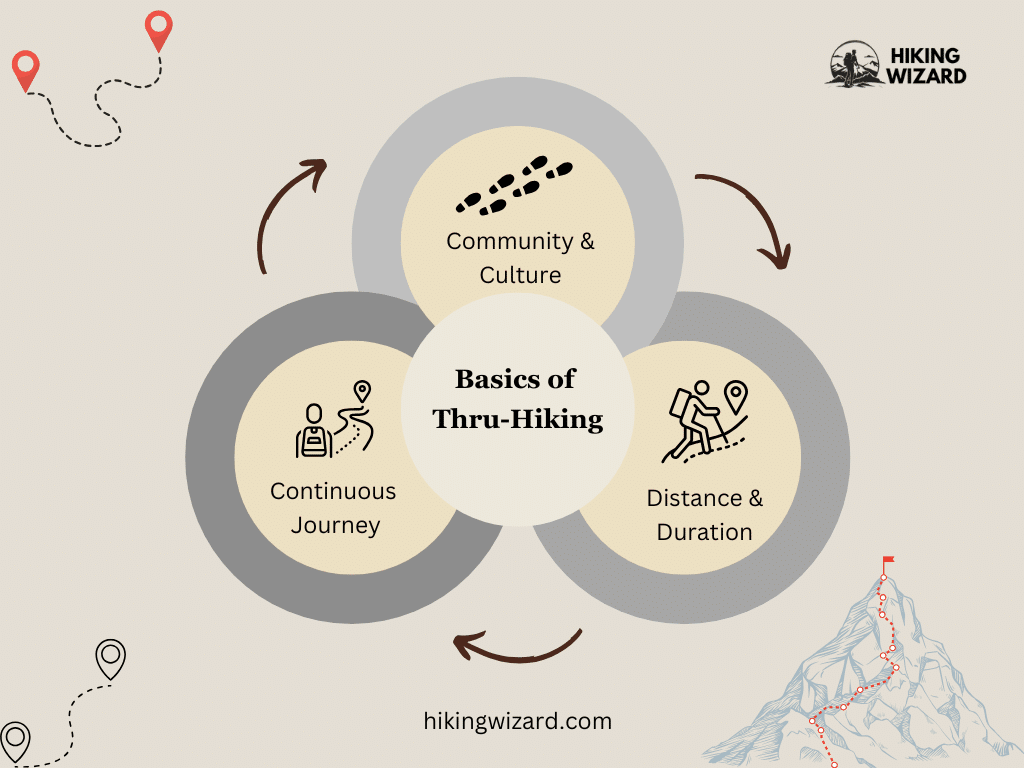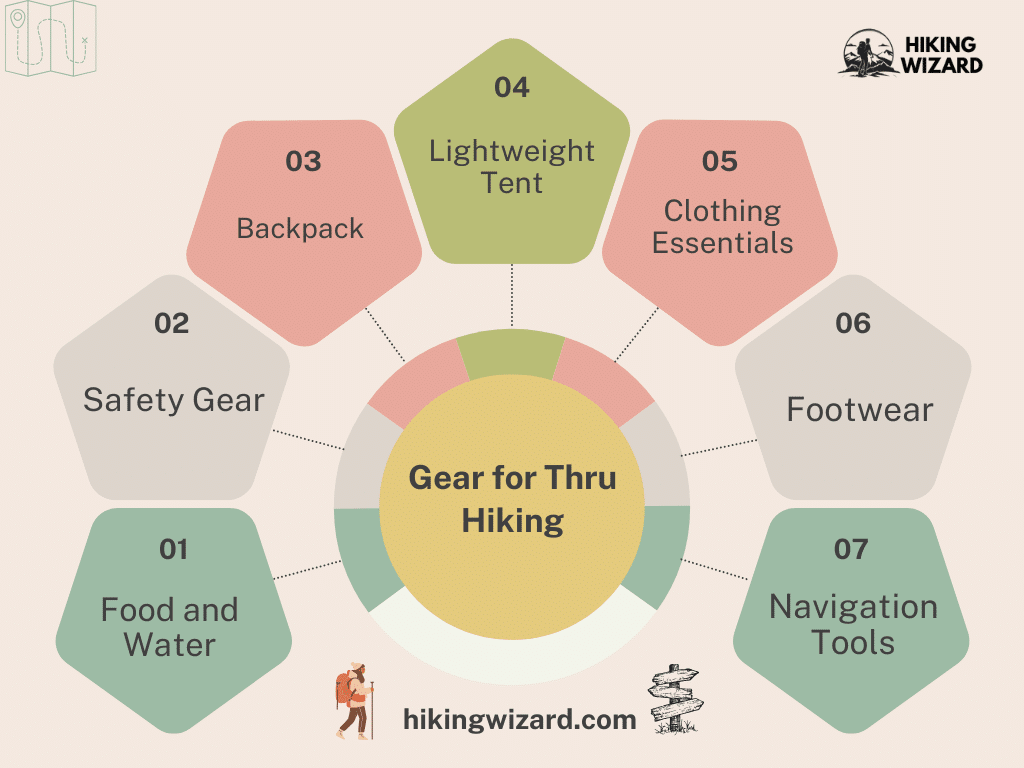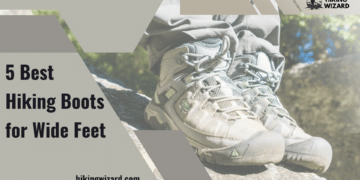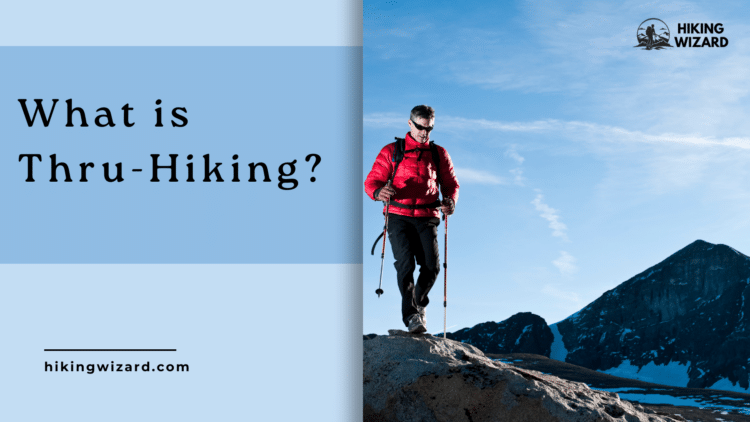Hiking has exploded in popularity, and it’s easy to see why; it’s all about pushing limits and uncovering nature’s secrets! From tackling switchbacks to scrambling over rocky trails, every route brings a fresh thrill. For the ultimate adventure, let’s talk thru-hiking, the ultimate badge of honor in the hiking world. Picture yourself embarking on a continuous, long-distance trek that tests your endurance, resilience, and grit. The reward? A profound sense of accomplishment and bragging rights that last a lifetime! So, if you’re ready to level up and expand your horizons, lace up those boots. Your next milestone adventure is calling! 🥾✨
So, What is Thru-Hiking?

Thru-hiking is the ultimate hiking challenge; it’s all about trekking an entire long-distance trail from start to finish in one epic adventure. Think of it as a hiking marathon, where you test your endurance, build stamina, and soak in jaw-dropping views along the way.
It’s not just about walking; it’s about living the trail life, finding your limits, and then smashing right through them. Whether it’s the Appalachian Trail or the Pacific Crest Trail, thru-hiking is the perfect blend of sweat, scenery, and a serious sense of accomplishment. Ready to take the leap? 🥾✨
Origins and History
Before discussing the nuances and intricacies of a thru-hike, it is important to learn about its roots and origins.
- Early Explorations: The idea of long-distance hiking originated with early naturalists and explorers who ventured into undiscovered areas. But with the development of lengthy paths, thru-hiking, as we know it today, took shape.
- Appalachian Trail: Thru-hiking is thought to have originated on the Appalachian Trail, which was finished in 1937. The AT was created in 1921 by planner and forester Benton MacKaye as a means of reestablishing human contact with the natural world. Spanning more than 2,190 miles from Georgia to Maine, it is the only path that thru-hikers have finished entirely in a single, uninterrupted trip.
- Expansion: As part of the “Triple Crown” of hiking in the United States, the Appalachian Trail’s success sparked the construction of additional long-distance trails, including the Pacific Crest Trail (PCT) and the Continental Divide Trail (CDT). These challenges have appealed to both long-distance hikers and section hikers.
Basics of a Thru-Hike

Now that you know what a thru-hike is, let’s move toward the basics of this type of hiking endeavor.
- Continuous Journey: Thru-hiking entails finishing a trail in its entirety in a single hike, usually in a single season. While section hiking permits occasional breaks and trail revisits, thru-hiking necessitates a persistent dedication.
- Distance and Duration: Depending on the path and the hiker’s speed, Thru-hikes can range in length from several hundred to thousands of miles and take anywhere from a few weeks to six months to finish. These kinds of long-distance trail activities are not for the weak of the heart.
- Community and Culture: Thru-hiking has its own subculture, characterized by distinctive customs, monikers for trails, and a sense of solidarity among hikers. Because hikers frequently encounter and encourage one another through trail magic along the journey, it promotes a sense of community.
The Difficulties of Thru-Hiking
Knowing that thru-hiking is a bit different from regular trails, explaining the challenges during this hike that a thru-hiker comes across makes him well-prepped.
- Physical Demands: Thru-hiking necessitates a high level of physical fitness because hikers must travel large distances every day, frequently over difficult terrain and in unpredictable weather. For comfort and support, the right hiking boots or backpacking boots are crucial.
- Mental Resilience: The journey’s isolation, exhaustion, and erratic conditions can be mentally taxing. Maintaining your motivation is essential to finishing the hike.
- Logistical Obstacles: The journey presents additional logistical problems, such as arranging resupply locations, handling food and water, and following trail rules. Backpacking necessitates flexibility and meticulous planning.
The Planning Procedure for Thru-Hiking
If you are ready to push your boundaries and expand your horizons, it is time to move on to the next step, i.e., Preparation.
- Research and Preparation: It is imperative to conduct in-depth research about the selected trail. Planning is made easier when one is aware of trail conditions, weather trends, and potential dangers. Selecting between hiking and backpacking is also important, depending on your comfort level and degree of experience.
- Permits and Regulations: Advance permission is required for numerous long-distance trails, such as the Pacific Crest Trail and the Continental Divide Trail (CDT). To guarantee a trouble-free voyage, familiarize yourself with the rules and restrictions established by groups such as the Appalachian Trail Conservancy.
- Training: Regular trekking and exercise are essential for developing physical endurance. A weighted backpack and a gradual increase in distance can help your body prepare for the demands of thru-trekking.
Gear Required for Thru-Hiking

As a thru-hiker, you must know what gear is needed for this type of hiking to achieve success.
- Backpack: Pick a bag that is comfortable, light, and has enough space to include all of your necessities.
- Shelter: A lightweight tent, tarp, or hammock is essential for protection during the hike.
- Clothing: Choose quick-drying, moisture-wicking apparel appropriate for a range of weather circumstances. The secret to adjusting to variations in temperature is layering.
- Footwear: For support and comfort on extended hikes, invest in sturdy, well-fitting trekking boots or backpacking boots.
- Navigation Tools: Carry a map, compass, and/or GPS device to stay on course and navigate through difficult areas.
- Food and Water: Prepare and bring high-calorie, light meals. A dependable water filtration system is necessary for safe hydration.
- Safety Gear: For added security and readiness, carry a first aid kit, multitool, headlight, and emergency whistle.
However, if you want to explore different hiking types, check out this article.
Conclusion
Summing up, the article covered details on the concept of a challenging hike type, i.e., e-thru-hiking. So, if you are one of those folks who love to explore the wilderness of nature, then this guide is a lifesaver for you. Clean your hiking boots, and get ready to take your hiking endeavors to whole new levels.



















